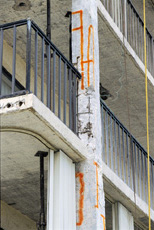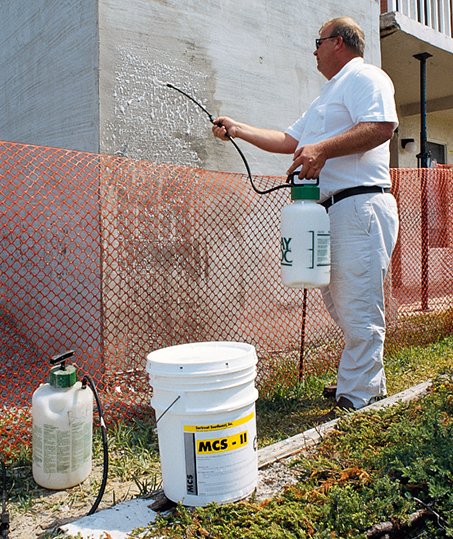Concrete Solution
Billions of dollars worth of structures are literally eaten away by corrosion. To fight this destruction, a NASA Space Act agreement merged Kennedy Space Center (KSC) research, tied to electrical treatments of structural corrosion, with chemical processes developed by Surtreat Southeast, Inc., of Cape Canaveral, Florida.
KSC materials scientists became experts regarding an electrical treatment known as electromigration. This procedure sends corrosion-inhibiting ions to the rebar, or steel bars within a concrete slab, to prevent it from rusting, corroding and separating from the concrete.
The issue was coming up with a viable treatment that can be repeatedly applied to counter the Florida clime-- a mix of salt, moisture, and baking sun. While that trio adds up to an ideal situation for tourists, it's a triple-header threat to launch pads, as well as miles of beachfront condos and other buildings.
Indeed, the aging oceanfront condominium market, as well as seaside commercial buildings, are in constant need of upkeep and restoration. The steel reinforcement bars--called rebars--that are embedded in concrete patio floors of beachside condo units have been particularly hard hit. Cracks and splitting of the concrete are major headaches. Cracks allow more water, more salt, and more acid to enter. Penetration accelerates, causing larger cracks and spalling. This troublesome material malady hits many concrete structures with decks that face the beach. Balconies in Florida have been deteriorating at a rapid pace.
With the help of Florida's Technology Research and Development Authority, an independent state agency that partners with KSC in technology transfer initiatives, Surtreat Southeast approached KSC with a chemical option to fight structural corrosion. Surtreat's GPHP product is applied to the surface of a corroding concrete slab and then seeps through to the rebar, coating it and preventing further corrosion.
"It corrects the chemical imbalance that causes the rebar to corrode. Traditional structural repair methods only last a couple of years," explains Jim Emory, president of Surtreat Southeast.
Emory explains that concrete, due to aging and other factors, loses its pH, or acidity value. Poured concrete has a high pH value of 11, 12, or 13. That high value can inhibit corrosion. The aging of the concrete is a natural process in which the pH starts to drop. When the pH value dips into the 8 to 9 range, there is potential for corrosion of the reinforcing bars, he points out.
Combining Surtreat's GPHP with electromigration fit well in the KSC dual use program, part of NASA's technology transfer and commercialization effort. That combination is expected to result in a unique process with broad corrosion control applications. Saving money
by NASA and others is anticipated by creating a structural repair method that lasts longer than just a couple of years.
The cooperative effort involved Surtreat providing to NASA the corrosion-inhibiting chemical and concrete test slabs, along with technical and staff support as needed. From KSC, testing specifications and procedures were provided. The NASA center also prepared the test slabs with the Surtreat chemical and carried out an environmental evaluation of the treatment. KSC materials scientists reviewed the applicability of the chemical treatment to the electromigration process and is preparing a report on its effectiveness following a 12-month test program.
The results could have national importance, says Rupert Lee, the NASA project engineer leading the joint effort. "Any breakthrough in corrosion mitigation technology will have a significant impact on the integrity of this nation's infrastructure," he explains.

Salty sea breezes create spalling on Florida’s concrete balconies. The salt migrates down to the steel reinforcing bars, rusting the bars and cracking the concrete. The edges and surfaces get unsightly and structural damage occurs in support columns.

The cracked (spalled) concrete must be chipped away and replaced. The Surtreat chemical is sprayed on the concrete and exposed steel bars.













